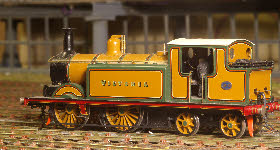



Last updated April 2023
With the completion of the Gladstone, E4X and I2, we are now building three more engines, bringing the total roster to 32 Brighton engines, and four industrials. When these three new engines (E2, B2, C3) are complete we will have a representative of virtually every class of LBSCR engine in the period 1900-1914, with the exception of the H1 nd H2 classes, and some of ‘X’ classified engines fitted with I1 or I2 boilers.
The E2 is featured as an example of scratchbuilding a loco body here.
The loco index leads to photographs and descriptions of most of our locos. Nearly all of my earlier locos were scratchbuilt for the simple reason that when I started over 40 years ago, there were very few kits of Brighton prototypes, so scratchbuilding was the only alternative. Having now built quite a few kits I think in many respects scratchbuilding is no more difficult than kit building, and it opens the door to building a unique collection of unusual prototypes. (The honourable exception to this is the High Level Model kits which are excellent in every respect - well-designed, and with really good instructions and diagrams).
All the locos have handbuilt chassis, fully compensated, and with split-axle pick-up (with the exception of the HLModels locos, which have scraper pickups). Many were built originally with open frame motors (mostly Anchoridge D11's and D13's) but most have now been converted to Portescaps or Mashimas, with much improved running.
With the completion of the Gladstone, E4X and I2, we are now building three more engines, bringing the total roster to 32 Brighton engines, and four industrials. When these three new engines (E2, B2, C3) are complete we will have a representative of virtually every class of LBSCR engine in the period 1900-
The E2 is featured as an example of scratchbuilding a loco body here.
The loco index leads to photographs and descriptions of most of our locos. Nearly all of my earlier locos were scratchbuilt for the simple reason that when I started over 40 years ago, there were very few kits of Brighton prototypes, so scratchbuilding was the only alternative. Having now built quite a few kits I think in many respects scratchbuilding is no more difficult than kit building, and it opens the door to building a unique collection of unusual prototypes. (The honourable exception to this is the High Level Model kits which are excellent in every respect -
All the locos have handbuilt chassis, fully compensated, and with split-